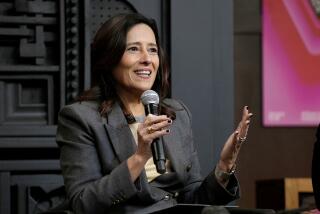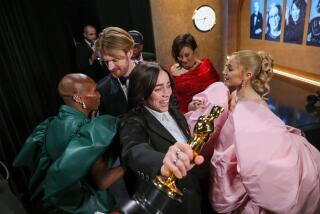Cinematographer is surprise winner to lead film academy as major transformation continues
Cinematographer John Bailey, whose credits include such films as “Ordinary People,” “The Big Chill,” and “Groundhog Day,” will be the new president of the Academy of Motion Picture Arts and Sciences, charged with helping to lead the nearly 90-year-old institution through the next phase of its ongoing public transformation.
In a meeting on Tuesday evening at the academy’s Beverly Hills headquarters, the group’s 54-member board of governors, including such Hollywood luminaries as Tom Hanks, Whoopi Goldberg, Kathleen Kennedy and Steven Spielberg, elected Bailey to succeed outgoing President Cheryl Boone Isaacs, who served four consecutive yearlong terms and steered the organization through one of the most transformative and sometimes turbulent periods in its long history.
Among academy watchers, Bailey’s election came as a surprise. Though active campaigning for the job of president is frowned on, in the weeks leading up to the election, the names most frequently mentioned in the rumor mill were documentary filmmaker Rory Kennedy, casting director David Rubin and actress Laura Dern.
In decades past the role of academy president, which is unpaid, was largely ceremonial. But in recent years, as the organization has taken a series of dramatic steps to remake itself inside and out, the job has grown more demanding — and the public scrutiny has grown more intense. “Holy mackerel, it’s changed,” Boone Isaacs told The Times in an interview this spring, speaking of the increasing spotlight on the academy and its leadership. “I’m assuming that’s not going away.”
Indeed, the 74-year-old Bailey, a board member representing the cinematographers branch, will immediately inherit a handful of major challenges facing the organization, including an ongoing push to diversify its overwhelmingly white and male membership ranks, an ambitious and costly effort to build an academy museum in Los Angeles and the erosion in ratings for the all-important Oscars telecast in recent years.
As the academy works to move past the recent #OscarsSoWhite firestorm and a string of perceived public missteps — including this year’s highly embarrassing Oscar-night gaffe, in which the wrong film was initially announced as best picture — some within the organization believed a well-liked celebrity such as Dern could help boost its public image. But Bailey, who received the American Society of Cinematographers Lifetime Achievement Award in 2014 and has served on the board of governors for 14 years, emerged as a late contender and won a consensus.
Under the leadership of Boone Isaacs, who was the first African American to serve as academy president, the organization weathered some of the most difficult public relations crises it had ever faced. In 2016, in response to a growing controversy over its selection for the second consecutive year of an all-white slate of acting nominees, the academy announced a sweeping campaign aimed at doubling the number of women and minorities in its membership by 2020. While the diversity initiative has been widely applauded, it was met early on with sometimes bitter pushback from some older rank-and-file members who felt they were being unfairly tarred with the brush of racism.
In the last two years, the academy has opened its doors to the largest and most diverse classes of new members in its history. In June, a whopping 774 industry professionals were invited to join the organization, 39% of whom were female and 30% of whom were people of color, bringing the overall share of women and minorities among the more than 7,000 members to 28% and 13%, respectively. (In a landmark 2012 analysis, The Times reported that Oscar voters at the time were 23% female and 6% nonwhite.)
As he steers the academy forward, Bailey — whose career stretches back to the 1970s and whose most recent credits include “A Walk in the Woods” and “How to Be a Latin Lover” — will work closely with academy CEO Dawn Hudson, who oversees the academy’s staff of approximately 350 and whose contract was recently renewed through June 2020. Hudson has herself at times been a polarizing figure within the academy’s leadership over what some view as her hard-charging style and in particular her stewardship of the museum, which is currently projected to open in 2019.
The board also elected, or in some cases reelected, a number of other officers for one-year terms, including Lois Burwell as first vice president and chair of the awards and events committee; Kathleen Kennedy as vice president and chair of the museum committee; Jim Gianopulos as treasurer and chair of the finance committee; and Rubin as secretary and chair of the membership and administration committee.
For Bailey, leading a proudly tradition-bound institution that finds itself in many ways at a crossroads will undoubtedly bring its share of challenges. But speaking to The Times in May as her tenure was winding down, Boone Isaacs said she was confident that whoever took the reins as president next would have the skills needed to lead the institution forward.
“Listen, this organization was great before I took this position and it’ll be great after I leave,” she said. “It’s just an evolution of change, and this is an exciting time.”
Twitter: @joshrottenberg
ALSO
‘Hamilton’ is here: A sneak peek at the landmark musical’s arrival in L.A.
Glen Campbell dies at 81; country-pop singer battled Alzheimer’s
Review: Kesha’s stalled story is finally moving again with the vivid ‘Rainbow’
More to Read
Only good movies
Get the Indie Focus newsletter, Mark Olsen's weekly guide to the world of cinema.
You may occasionally receive promotional content from the Los Angeles Times.







